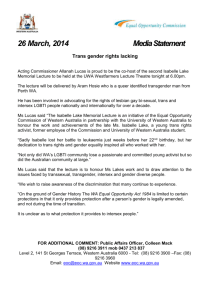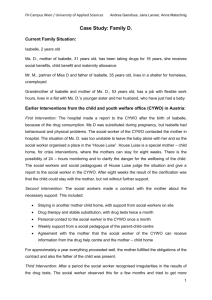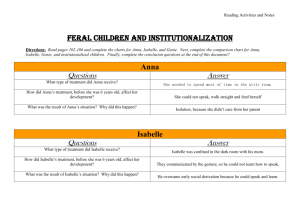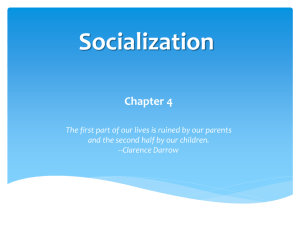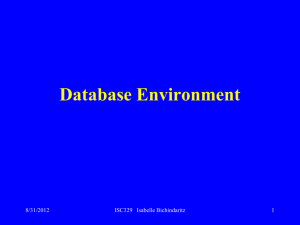Database systems design
advertisement
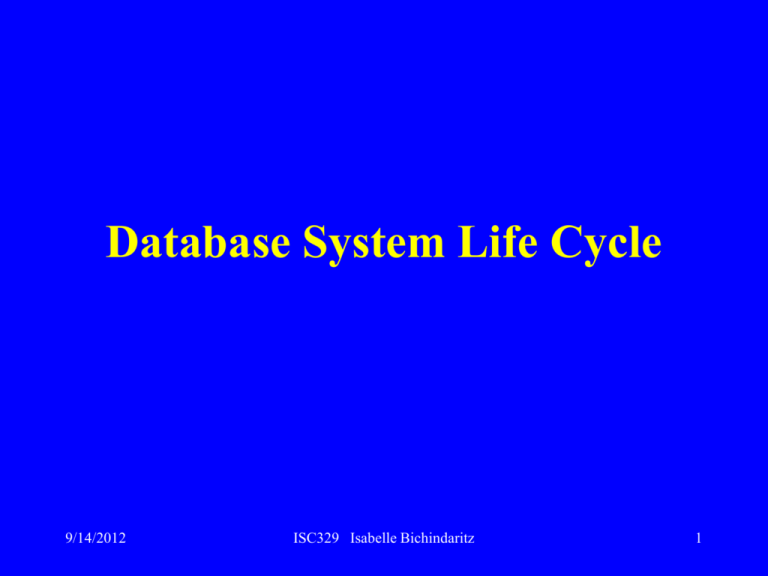
Database System Life Cycle 9/14/2012 ISC329 Isabelle Bichindaritz 1 Objectives • Purpose of a design methodology. • Database design has three main phases: conceptual, logical, and physical design. 9/14/2012 ISC329 Isabelle Bichindaritz 2 Acknowledgments • Some of these slides have been adapted from Thomas Connolly and Carolyn Begg 9/14/2012 ISC329 Isabelle Bichindaritz 3 Design Methodology • Structured approach that uses procedures, techniques, tools, and documentation aids to support and facilitate the process of design. • Database design methodology has 3 main phases: – Conceptual database design; – Logical database design; – Physical database design. 9/14/2012 ISC329 Isabelle Bichindaritz 4 Preliminary Phase : Database Initial Study • Purposes – Analyze company situation • Operating environment • Organizational structure – Define problems and constraints – Define objectives – Define scope and boundaries 9/14/2012 ISC329 Isabelle Bichindaritz 5 Business Rules • What are business rules, what is their source, and why are they crucial? • Business rules are precise statements, derived from a detailed description of the organization's operations, that define one or more of the following modeling components: – – – – – entities - in the E-R model corresponds to a table relationships – are associations between entities attributes – are characteristics of entities connectivities – are used to describe the relationship classification multiplicities – express the specific number of entity occurrences associated with one occurrence of the related entity – constraints – limitations on the type of data accepted 9/14/2012 ISC329 Isabelle Bichindaritz 6 Business Rules • Examples of business rules are: – An invoice contains one or more invoice lines, but each invoice line is associated with a single invoice. – A store employs many employees, but each employee is employed by only one store. – A college has many departments, but each department belongs to a single college. (This business rule reflects a university that has multiple colleges such as Business, Liberal Arts, Education, Engineering, etc.) – A driver may be assigned to drive many different vehicles, and each vehicle can be driven by many drivers. (Note: Keep in mind that this business rule reflects the assignment of drivers during some period of time.) – A client may sign many contracts, but each contract is signed by only one client. 9/14/2012 ISC329 Isabelle Bichindaritz 7 Changing Data into Information • Data – Raw facts stored in databases – Need additional processing to become useful • Information – Required by decision maker – Data processed and presented in a meaningful form – Transformation 9/14/2012 ISC329 Isabelle Bichindaritz 8 The Information System • Database – Carefully designed and constructed repository of facts – Part of an information system • Information System – Provides data collection, storage, and retrieval – Facilitates data transformation – Components include: • People • Hardware • Software –Database(s) –Application programs –Procedures 9/14/2012 ISC329 Isabelle Bichindaritz 9 The Information System • System Analysis – Establishes need and extent of an information system • System development – Process of creating information system • Database development – Process of database design and implementation – Creation of database models – Implementation • Creating storage structure • Loading data into database • Providing for data management 9/14/2012 ISC329 Isabelle Bichindaritz 10 Database Lifecycle (DBLC) Figure 6.3 9/14/2012 ISC329 Isabelle Bichindaritz 11 Initial Study Activities 9/14/2012 ISC329 Isabelle Bichindaritz 12 Use case diagram User Place contact KnowledgeBase extends <<uses>> <<uses>> View contact PrimaryCareProvid er DecisionSupportSys tem <<uses>> Browse contacts<<uses>> Authenticate user User <<uses>> Generate statistics ElectronicMedicalRe cord extends Provide solution LTFUSpecialist <<extends>> <<extends>> Create solution 9/14/2012 KnowledgeBase Review solution ISC329 Isabelle Bichindaritz 13 Conceptual/Logical Database Design • Conceptual database design – Process of constructing a model of information used in an enterprise, independent of all physical considerations. • Logical database design – Process of constructing a model of information used in an enterprise based on a specific data model (e.g. relational), but independent of a particular DBMS and other physical considerations. 9/14/2012 ISC329 Isabelle Bichindaritz 14 Physical Database Design • Process of producing a description of the implementation of the database on secondary storage; it describes the base relations, file organizations, and indexes design used to achieve efficient access to the data, and any associated integrity constraints and security measures. 9/14/2012 ISC329 Isabelle Bichindaritz 15 Critical Success Factors in Database Design • Work interactively with users as much as possible. • Follow a structured methodology throughout the data modeling process. • Employ a data-driven approach. • Incorporate structural and integrity considerations into the data models. • Combine conceptualization, normalization, and transaction validation techniques into the data modeling methodology. 9/14/2012 ISC329 Isabelle Bichindaritz 16 Critical Success Factors in Database Design • Use diagrams to represent as much of the data models as possible. • Use a Database Design Language (DBDL) to represent additional data semantics. • Build a data dictionary to supplement the data model diagrams. • Be willing to repeat steps. 9/14/2012 ISC329 Isabelle Bichindaritz 17 Methodology Overview Conceptual Database Design • Step 1 Build local conceptual data model for each user view – Step 1.1 Identify entity types – Step 1.2 Identify relationship types – Step 1.3 Identify and associate attributes with entity or relationship types – Step 1.4 Determine attribute domains – Step 1.5 Determine unique identifier (will become a key) attributes – Step 1.6 Consider use of enhanced modeling concepts (optional step) – Step 1.7 Check model for redundancy – Step 1.8 Validate local conceptual model against user transactions – Step 1.9 Review local conceptual data model with user 9/14/2012 ISC329 Isabelle Bichindaritz 18 Class diagram 9/14/2012 ISC329 Isabelle Bichindaritz 19 Methodology Overview - Logical Database Design for Relational Model • Step 2 Build and validate local logical data model for each view – Step 2.1 Remove features not compatible with the relational model (optional step) – Step 2.2 Derive relations for local logical data model – Step 2.3 Validate relations using normalization – Step 2.4 Validate relations against user transactions – Step 2.5 Define integrity constraints – Step 2.6 Review local logical data model with user 9/14/2012 ISC329 Isabelle Bichindaritz 20 Methodology Overview - Logical Database Design for Relational Model • Step 3 Build and validate global logical data model – Step 3.1 Merge local logical data models into global model – Step 3.2 Validate global logical data model against the conceptual data model – Step 3.3 Check for future growth – Step 3.4 Review global logical data model with users 9/14/2012 ISC329 Isabelle Bichindaritz 21 Methodology Overview - Physical Database Design for Relational Databases • Step 4 Translate global logical data model for target DBMS – Step 4.1 Design base relations – Step 4.2 Design representation of derived data – Step 4.3 Design enterprise constraints • Step 5 Design physical representation – – – – Step 5.1 Step 5.2 Step 5.3 Step 5.4 9/14/2012 Analyze transactions Choose file organization Choose indexes Estimate disk space requirements ISC329 Isabelle Bichindaritz 22 Methodology Overview - Physical Database Design for Relational Databases • Step 6 Design user views • Step 7 Design security mechanisms • Step 8 Consider the introduction of controlled redundancy • Step 9 Monitor and tune the operational system 9/14/2012 ISC329 Isabelle Bichindaritz 23

